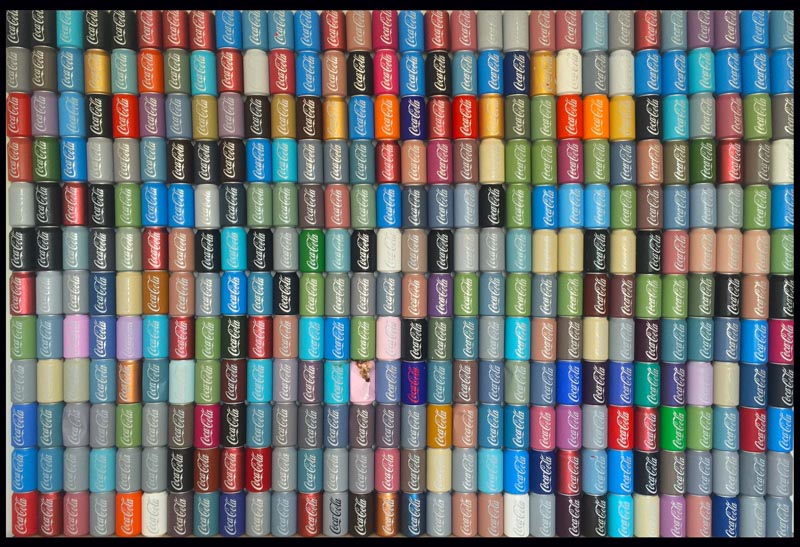
자연으로부터의 그림 I 작가 팡즈융의 성장과 진화
자연으로부터의 그림 중국 작가 팡즈융의 성장과 진화
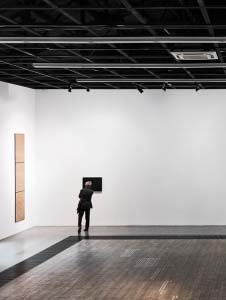
발견이란 새로운 것을 찾아내는 것만큼이나, 이미 알고 있지만 어쩐지 기억하지 못하는 것을 되새기는 것이라고 말할 수 있습니다. 콜럼버스는 신대륙을 발견한 것일까요, 아니면 유럽인들에게 오랫동안 잊혀졌던 땅을 상기시킨 것일까요? 우리가 잊었다가 발견을 통해 다시 기억하는 것이 우리의 본성일까요? 예술가가 사업가나 과학자보다 먼저 새로운 것을 발견할까요? 아니면 예술가가 이미 무언가를 기억하고 있었고, 그것이 단지 다른 ‘언어’나 ‘매체’로 같은 이해를 표현하는 과학 방정식으로 변환되기만 하면 되는 것일까요? 콜럼버스가 ‘기억하기 위해’ 항해했듯이, 팡즈융은 이제 잊혀진 것을 발견하기 위해 창작한다고 말할 수 있습니다. 그리고 팡 작가가 오늘날 창조하는 작품 속의 어떤 발견들은 언젠가 다른 분야에서 일하는 이들에게 기억을 일깨울 것이고, 이 발견들은 다른 누군가에 의해 ‘발견’이라는 같은 이름으로 다시 불릴지도 모릅니다.
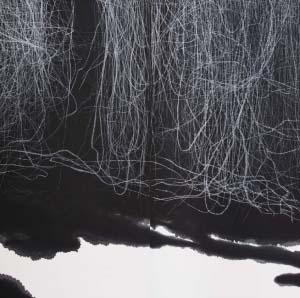
팡 작가는 “예술가가 작업을 시작할 때 모든 작품이 새로운 시작처럼 보이지만, 작품은 항상 그의 가장 깊은 마음속에 있는 무언가를 담고 있어 결코 잊을 수 없을 것 같다”고 말합니다. 그가 말하는 과정은 가장 최근에 그의 신작 시리즈와 조각의 주제가 되었습니다. 기억은 부재와 존재를 모두 포함합니다. 그것은 현실 세계에 존재하지만 마음속에는 부재하는 어떤 것을 드러내는 행위입니다. 존재하지 않는 것처럼 보이지만 단지 숨겨져 있는 것은 어떤 형태의 행위를 통해 무(無)에서 유(有)로 구현되어야 합니다. 부재했던 것이 이제 존재하게 되는 것입니다.
팡 작가에게 예술가는 자신이 선택한 매체로 형태를 구현함으로써 이를 달성합니다. 물리학자에게는 동일한 지식이 방정식으로 계산될 수 있습니다. 그리고 각 발견자의 표현 방식은 다른 ‘언어’나 ‘매체’로 같은 이해를 표현하는 과학 방정식으로 변환되기만 하면 되는 것일까요? 콜럼버스가 ‘기억하기 위해’ 항해했듯이, 팡즈융은 이제 잊혀진 것을 발견하기 위해 창작한다고 말할 수 있습니다. 그리고 팡 작가가 오늘날 창조하는 작품 속의 어떤 발견들은 언젠가 다른 분야에서 일하는 이들에게 기억을 일깨울 것이고, 이 발견들은 다른 누군가에 의해 ‘발견’이라는 같은 이름으로 다시 불릴지도 모릅니다. 발견의 모든 행위는 인류에게 어쩐지 항상 알려져 있었던 미지의 것을 상기시킵니다.
 발견과 놀이는 밀접하게 연관되어 있습니다. 그래서 팡 작가는 최근작에서 어린 시절 성인들이 깊이 이해했던 것, 즉 직소 퍼즐에 주목했습니다. 퍼즐은 모든 것을 연결하고 맞춰 하나의 전체를 부분들로부터 만들어냄으로써 발견을 표현합니다. 조각들의 촉각적 특성으로 인해 현존감을 불러일으킵니다. 또한 어린 시절의 기억을 자극하기 때문에 놀이의 방식으로 발견의 충동을 불러일으킵니다. 놀이는 아이들에게 연결하고 구성하는 방법을 가르칩니다. 아이들이 상상하는 것과 할 수 있는 것을 연결함으로써 어린 마음에 발견을 유도합니다. 직소 퍼즐은 아이로 하여금 형태를 보고 윤곽선을 사용하여 연결하도록 합니다. 어른들에게도 이것은 사라지지 않고 항상 마음속에 잠재되어 있으며, 반쯤 잊혀졌지만 결코 손이 닿지 않는 곳에 있지 않습니다.
발견과 놀이는 밀접하게 연관되어 있습니다. 그래서 팡 작가는 최근작에서 어린 시절 성인들이 깊이 이해했던 것, 즉 직소 퍼즐에 주목했습니다. 퍼즐은 모든 것을 연결하고 맞춰 하나의 전체를 부분들로부터 만들어냄으로써 발견을 표현합니다. 조각들의 촉각적 특성으로 인해 현존감을 불러일으킵니다. 또한 어린 시절의 기억을 자극하기 때문에 놀이의 방식으로 발견의 충동을 불러일으킵니다. 놀이는 아이들에게 연결하고 구성하는 방법을 가르칩니다. 아이들이 상상하는 것과 할 수 있는 것을 연결함으로써 어린 마음에 발견을 유도합니다. 직소 퍼즐은 아이로 하여금 형태를 보고 윤곽선을 사용하여 연결하도록 합니다. 어른들에게도 이것은 사라지지 않고 항상 마음속에 잠재되어 있으며, 반쯤 잊혀졌지만 결코 손이 닿지 않는 곳에 있지 않습니다.
팡 작가의 최근 시리즈는 강렬한 색상(빨강, 검정, 금색)과 각 직소 퍼즐을 사용하여 개인과 인간 집단의 본질에 대한 복잡한 성찰을 유도합니다. 빠진 조각이 있습니다. 그것은 잊혀진 것, 마음의 가장자리에 있는 것일까요? 아니면 자신의 집단에 잘 어울리지 못하는 사람일까요? 그 사람—그 조각—이 없어도 이미지는 온전할까요, 아니면 그 빠진 조각을 찾아 퍼즐을 완성하려는 욕구가 일어날까요? 그 연결을 만들고 그림을 완성하려는 욕구를 만들어냄으로써 상상 속에서 무엇이 발견될까요?
하지만 그 빠진 조각과 그 조각의 부재하는 색상은 무엇일까요? 금색은 중국 문화에서 부(富)를 상징하는 색입니다. 빠진 조각이 아무리 많은 사람들이 부를 열망하고 돈을 버는 데 자신들의 정체성을 투입하기 위해 다른 조각들 위에 덧칠을 한다 해도, 집단의 한 구성원은 항상 빠져 있을 것이라는 의미로 해석할 수 있을까요? 집단의 한 구성원은 결코 완전히 어울리지 못할까요? 아니면 이 조각을, 아무리 자신의 성격을 재정적 발전에 맞추려 노력해도 뭔가 잘 맞지 않는 사업가의 마음을 나타내는 것으로 해석해야 할까요?
팡 작가의 일부 작품에서는 많은 조각들이 빠져 있으며, 때로는 한가운데가 갈라진 것처럼 보이기도 합니다. 이 갈라진 틈은 서로 다른 언어나 문화를 만들어가는 과정에서 두 집단이 출현하는 것일까요? 사람들이 서로 멀어지며 그 사이에 간극을 남기는 것일까요? 이것이 문화가 형성되고, 분리되고, 다양하게 나타나는 방식일까요? 이렇게 많은 조각들이 남긴 검은 영역을 보면 거의 지구와 대륙이 서로 멀어지는 모습을 볼 수 있습니다. 거대한 단층이 형성되고 곧 바닷물이 밀려들 것입니다. 지질학적 시간으로 보면 곧 한때 하나였던 두 육지를 바다가 나눌 것입니다. 우리는 사람들을 보고 있는 것일까요, 아니면 지구 자체를 보고 있는 것일까요?
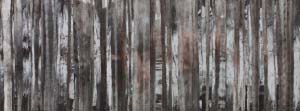
직소 퍼즐 안에서 자연 현상을 보는 것은 놀랄 일이 아닙니다. 팡 작가는 대학원에서 자연과 교감하고 나타나는 일련의 이미지들을 발견하면서 자신만의 성장 단계를 시작했습니다. 그는 나무, 들판, 바위와 돌의 형태를 성찰하고 다시 연결했습니다. 그가 자연에서 발견한 것을 표현하기 위해 선택한 매체는 또한 그가 중국 예술가로서의 뿌리, 즉 모든 중국 예술의 뿌리를 기억하는 길이었습니다. 팡 작가는 캔버스 대신 화선지를 선택했지만, 혼합 매체와 먹물을 결합했습니다. 먹물 외의 재료를 사용하여 현대 예술가로서의 정체성을 포용하면서도, 화선지에 작업함으로써 중국 예술가로서의 역사를 포용한 여러 연작들은 직접적으로 회화적인 것을 시도하기보다는 시각적으로 참조적인 성격을 띠었습니다. 숲은 부드러운 녹색과 갈색의 길고 얇은 층층이 쌓인 모습으로 변모했습니다. 나뭇잎이 조화롭게 흐르는 전통적인 나무 이미지라기보다는 나무의 나이테 단면처럼, 이미지의 아름다움은 오행 중 하나인 **’나무(木)’**에 대한 새롭게 발견된 이해를 만들어냅니다.
묘사하기보다는 표현하려는 의지는 마찬가지로, 땅의 돌들은 석양의 색과 광물의 강렬함에 잠겼습니다. 화선지 위에 추상적인 형태들은 먹물과 광물성분을 통합하여 보라색과 은색, 회색을 드러냅니다. 이 창작물 중 하나에서 두 가지 중국의 추가 요소인 **’광물(金)’과 ‘흙(土)’**이 나타납니다. 어떤 돌도 그림으로 표현되지 않았음에도 불구하고, 마치 돌들을 알게 된 듯한 느낌을 받습니다. 마치 팡 작가가 숲에 가서 돌들과 함께 앉아 그들이 감추고 있는 비밀을 감지한 것처럼, 그는 자연에 대한 새로운 이해와 그 존재를 시각적으로 표현하는 신선한 방식을 발견했습니다.
흙, 광물, 나무와 함께 팡 작가는 오행 중 세 가지와 나란히 걸으며 자연으로의 여정을 시작했습니다. 그러나 자연은 자연으로부터 진화합니다. 대륙이 표류하는 것처럼 사람들도 그렇습니다. 마음속의 잃어버린 조각들과 집단에서 사라진 사람들은 대륙 사이의 간극과 다르지 않습니다. 그러한 간극이 커지면서 모든 것은 결국 물, 익사, 고립으로 이어질 수 있습니다. 또는 새로운 것이 탄생할 수도 있습니다. 네 번째 요소인 **’물(水)’**은 퍼즐 안에서 이러한 움직임 속에서 잊혀진 조각들일 수 있습니다. 금색으로 칠해진 퍼즐이 전체 밖에 남아 있는 단 하나의 조각, 단 한 사람을 궁극적으로 견뎌낼 수 있을지 물을 수 있습니다. 금색은 단지 일시적인 색상이고 조각들이 재배치되면서 풍부한 색상 변화가 나타날까요?
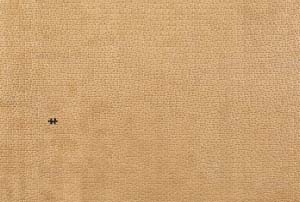
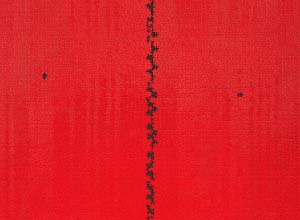
알 수 없는 것을 인식하고, 존재하는 것 속의 부재를 포착하며, 팡 작가는 숲을 넘어 쉽게 볼 수 없지만 들을 수 있는 곳으로 더 깊이 나아갔습니다. 그는 나무와 바위에 대한 시각적 참조를 표현했지만, 시각적 묘사에서 빠진 또 다른 조각인 그들의 소리는 어떠할까요? 《쇼팽의 상상의 선(The Imaginary Lines of Chopin)》 연작에서 그는 소리를 시각적 형태로 어떻게 표현할지 고심했습니다. 쇼팽의 음악을 들으며 저녁 한때 휴식을 취하던 순간, 그는 들을 수 있는 것과 그것이 어떻게 보일 수 있는지 사이의 관계를 발견했습니다. 이 연작에서 음악적 형태는 현악기의 움직임으로 표현됩니다. 일부는 평화롭고 조화로우며, 다른 일부는 시끄럽고 분열적입니다. 다시 화선지를 매체로 선택함으로써 그는 자신이 묘사하는 자연과 함께 자신의 정체성을 총체적으로 포용했습니다.
그러나 자신의 정체성 또한 자연의 일부가 아니었을까요? 바위와 나무를 묘사하는 것은 예술가와 대상 사이에 분리된 관계를 유지합니다. 소리는 볼 수 없는 자연의 일부로 시각 매체의 이해에 도전했습니다. 하지만 더 깊이 들어가야 할 필요성이 제기되었습니다. 예술가 자신도 자연의 일부이며, 예술가가 표현할 때 그는 이해된 것과 아직 알 수 없지만 기억될 수 있는 것 모두로부터 표현합니다. 예술가가 그림을 그릴 때, 그는 알려진 것과 알려지지 않은 것 모두를 발견합니다. 하지만 그는 존재해야 할 것들을 생략할 수도 있습니다.
예술가의 본성은 창조하는 것이라고 말할 수 있습니다. 하지만 예술가 또한 자연의 일부입니다. 팡 작가는 자연으로부터 그림을 그림으로써 자연에서 시작하기를 선택했습니다. 그리고 팡 작가는 자신의 진화 속에서 우리가 성장하는 단계를 통해 기억, 이해, 집단 속 사람들의 존재와 부재를 탐구하도록 이끌어줍니다. 우리는 무엇을 기억했습니까? 그리고 무엇을 잊기로 선택했습니까?
돌에서 현으로, 그리고 직소 퍼즐로. 이 게임은 어린아이 같은 발견의 경이로움을 불러일으킵니다. 하지만 노벨상 수상자들과 수학자들 또한 게임이 보이는 것보다 훨씬 더 복잡하다는 것을 알고 있습니다. 게임 이론의 이론적 측면은 아이들의 장난이 아닙니다. 팡 작가 진화의 이 단계는 가장 단순한 관점에서 인간 본성을 탐구함으로써 자연에 대한 이해를 진전시켰습니다. 게임을 하는 아이, 광물이 번쩍이는 바위, 나이테가 있는 나무, 현에서 울림이 있는 음악. 팡 작가는 자연으로부터 그림을 그리며 자신의 본성에 따라 발견을 창조하고 있습니다.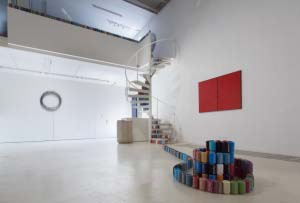
스위스 물리학자 **볼프강 파울리(Wolfgang Pauli)**는 오스트리아, 스위스, 독일의 대성당에 있는 장미창의 아름다움을 성찰하고 꿈꾸며 많은 시간을 보냈습니다. 이 창들은 영적인 감정에서 영감을 받아 당대 최고의 장인들에 의해 만다라 이미지 형태로 제작되었습니다. 바로 이 시각적 표현 속에서 파울리에게 기억의 불꽃이 솟아올랐습니다. 수년 후, 이 형태들의 패턴은 파울리의 배타 원리—그에게 노벨상을 안겨준 업적—의 방정식으로 구현되었습니다. 영적인 이해에 대한 발견은 아름다움과 균형에 대한 또 다른 발견이 되었고, 이는 다시 장미창의 형태로 표현된 장인의 발견이 되었습니다. 그리고 장미창의 형태는 또 다른 발견이 되었습니다. 이번에는 이제 파울리의 배타 원리에서 기억되는 방정식의 형태였습니다. 현대 과학은 이제 물리학자의 표현 매체, 그의 붓, 즉 방정식의 형태로 변모했습니다. 배타 원리는 장미창의 도움으로 발견되었고, 이제 파울리의 발견과 함께 기억되었다고 말할 수 있습니다. 발견의 단계는 기억의 진화로 추적될 수 있습니다. 팡즈융은 현재 망각의 역동성을 발견하고 있습니다. 팡 작가의 그림에서 배제된 퍼즐 조각이 인간 진화와 자연으로부터의 우리의 성장, 그리고 우리의 성장의 본질에 어떤 의미를 가질까요?
